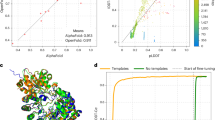Abstract
J. H. LAMBERT should be given precedence over Gauss as the originator of the theory of errors. Galle1 stated that Gauss arrived at the idea of the principle of least squares while reading Lambert, but he did not mention the essence of Lambert's work on the subject. Furthermore, no mention has been made of this in the various works on Lambert2–4.
This is a preview of subscription content, access via your institution
Access options
Subscribe to this journal
Receive 51 print issues and online access
$199.00 per year
only $3.90 per issue
Buy this article
- Purchase on Springer Link
- Instant access to full article PDF
Prices may be subject to local taxes which are calculated during checkout
Similar content being viewed by others
References
Galle, A., Uber die Geodätische Arbeiten von Gauss, C. F. Gauss, Werke, 11, Abt., 2 (1924–9).
Lambert, J. H., Nach seinem Leben und Wirken (Herausgegeben D. Huber, Basle, 1829).
Barthel, E., Archiv für Geschichte der Mathematik, der Naturwissenschaften und der Technik, 11, N1–2 (1928).
Lambert, J. H., Opera Mathematica, 1–2 (Zürich, 1946–8).
Lambert, J. H., Photometria, Sive di Mensura et Gradibus Luminis Colorum et Umbrae (Angustae Vindelicorum, 1760, art. 271–306).
Lambert, J. H., Theorie der Zuverlässigkeit der Beobachlung und Versuche (Beytrage zum Gebrauche der Mathematik und Deren Anwendung, 1, B, 1765).
Lambert, J. H., Anmerkungen und Zusätze zur practischen Geometrie (Beytrage zum Gebrauche der Mathematik und Deren Anwendung, 1, B, 1765).
Galilei, G., Dialogue Concerning the Two Chief World Systems, day Third described by Majstrov, L. Ye, in Voprosi istorii Jestestvosnanija i Techniki, 16 (1964); J. Abs. Mathematica, 9A22 (1964).
Laplace, P. S., Mémoire sur la Probabilité des Causes par les Événements, Oeuvres Completes, 8, P (1891).
Euler, L., Piece qui a remporté le Prix de l'Acad. Roy. Sci. en 1748, P, art. 122–3 (1749).
Lagrange, J. L., Misc. Taurinensia, 5, 1770–1773, s.a. (Oeuvres, t. 2).
Abbe, E., Dissertation zur Erlangung der Venia Docendi bei der Philos. Fakultät Jena, 1863 (Gesammelte Abhandlungen, 2, Jena, 1906). Beytrage zum Gebrauche der Mathematik und Deren Anwendung, 1, B,
Gore, G. H., A Bibliography of Geodesy (U. S. Coast and Geodetic Survey Report for 1887, 1889).
Helmert, F. R., Die Ausgleichung Nach der Methode der Kleinsten Quadrate (1924).
Cramer, H., Mathematical Methods of Statistics, art. 18, 1 (Princeton, 1946).
Author information
Authors and Affiliations
Rights and permissions
About this article
Cite this article
SHEYNIN, O. Origin of the Theory of Errors. Nature 211, 1003–1004 (1966). https://doi.org/10.1038/2111003b0
Issue Date:
DOI: https://doi.org/10.1038/2111003b0
Comments
By submitting a comment you agree to abide by our Terms and Community Guidelines. If you find something abusive or that does not comply with our terms or guidelines please flag it as inappropriate.



